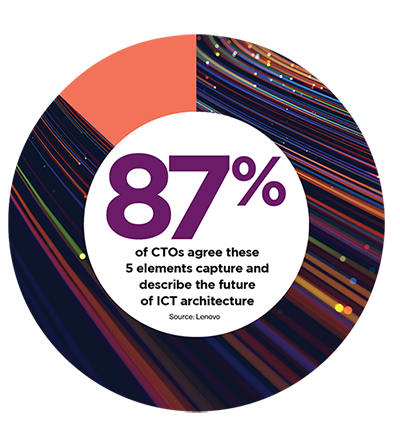
Building the backbone for innovation, speed and thriving humanity
This technology paradigm promises to support innovation and boost employee productivity, and also to power AI, revolutionize how enterprises use data, support business agility, and confront climate change with sustainable solutions.
The five elements of new IT
Although new technology and powerful applications are constantly emerging, Lenovo identifies five key components of a future-ready IT environment: smart devices, edge computing, cloud computing, high speed networks such as 5G, and AI. This definition resonates with technical leadership too, says Yuanqing, citing a 2022 Lenovo global research study of 500 chief technology officers in which four out of five CTOs agree it “captures and describes the future of information communications technology (ICT) ‘extremely’ or ‘very well.’”
Smart devices connect AI to human problems: According to Statista, the number of internet of things (IoT) devices worldwide will reach 29 billion IoT devices by 2030. IoT’s exponential growth—smart devices empowered by advanced sensors—provide a wide range of industries with competitive advantages.
Manufacturers can use smart devices like robots to stand in for workers in dangerous or remote workspaces, and accelerate and automate assembly lines. For example, Lenovo’s Daystar Robot works remotely in real time using telepresence and teleoperation and learns tasks as it goes. The robot is operated by a streaming augmented reality headset with 3D video to give the user a realistic view of the work being done. The user’s head position controls the robot arm, and a handheld device controls movements.
Edge computing helps data eliminate boundaries: Processing volumes of data can lead to performance issues. In response, many organizations are turning to edge computing, which processes data close to the source to enable fast and real-time analysis and response, while maintaining privacy and security requirements. “Edge computing allows data to be treated closer to where data is generated—directly at the edge site, lowering latency for faster response times, increased agility, and greater resilience,” says Yuanqing.
For example, Kroger, one of the largest grocery chains in the United States, teamed with Lenovo and visual AI technology provider Everseen to build a system of secure self-checkout kiosks. AI servers capture unstructured data at each checkout from 20 high-resolution cameras. The system detects if an item is not scanned, and prompts the customer to rescan. It can also ping an associate’s mobile device. Since this requires enormous computing power, an edge solution processes the data near the source. “Over 75% of checkout errors can be corrected without employee intervention,” says Yuanqing.
And global biodiversity nonprofit Island Conservation uses edge computing to bridge 400 miles of Pacific Ocean. At Robinson Crusoe Island, one of the most remote places on Earth, it uses camera traps to document endangered and invasive species. Camera data used to be stored on a hard drive and periodically flown to Santiago, Chile to process, taking as long as three months. Today, edge computing data centers process data on the island—time-savings that can save lives. “The Island Conservation team can process six months’ worth of visual data within just one week, enabling them to draw analytical insights within minutes instead of weeks,” Yuanqing says.

Cloud computing provides connection: If the pandemic taught technology leaders anything, it’s that public, private, hybrid, and multicloud computing is imperative for fast and agile services and development.

